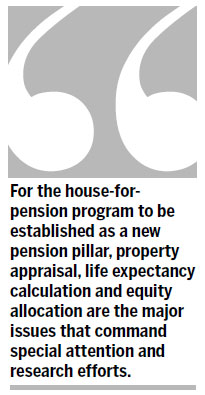Plan to help the elderly
Updated: 2013-09-27 07:01
By Zhao Xiao and Xue Xiaoyu (China Daily)
|
||||||||
Efforts needed to address the issues that make homeowners and financial institutions wary of houses for pensions
This month the State Council pledged to complete a social care network for people aged 60 or above by 2020. Among the proposed policies that are dedicated to serving the world's largest elderly population, the reverse mortgage loan plan has received mixed responses.
Under the policy, which is better known as a house-for-pension program, homeowners can deed their house over to an insurance company or bank, which will have the house appraised and calculate the applicant's life expectancy and then pay out a fixed amount of money every month. This would allow the elderly to live in his or her own house and receive regular payments for as long as they live. After they pass away, the house will be sold to repay the loan principal and interest, and the mortgagees will benefit from the increased value of the asset.
Reverse mortgages have become a practical choice for seniors across the United States, Canada, Japan and many other countries, as a financial tool to supplement people's pensions. In fact, the idea is not new in China. Back in 2003, the China Insurance Regulatory Commission submitted a report about reverse mortgages to the State Council, and several cities, including Shanghai and Nanjing, have tried the program since, but they have all fared poorly.

The China National Committee on Aging estimates that by the end of 2013, China will have more than 200 million citizens aged 60 or above, which will account for 14 percent of the total population. The existing number of public nursing homes cannot meet the growing demand of the rapidly aging population, and the new house-for-pension policy is intended to help the elderly live comfortable lives in their final years.
However, the State Council's latest proposal for reverse mortgages, while only a pilot program, faces an uphill battle for acceptance. One key barrier is the widespread skepticism among the elderly themselves.
The house-for-pension program is designed to free up cash for seniors and enable them to make better use of their housing resources. However, for many seniors, their houses are worth a lifetime of hard work, and it is not easy for them to borrow against their hard-earned equity. Even if they have more than one property they will be more willing to rent them out to get extra income.
There is also a cultural obstacle to reverse mortgages as houses are deemed the best choice of cementing the intergenerational bond. For this reason, many people believe that the program mainly serves the childless, those with deceased children or empty-nesters with children living apart. A lack of understanding about how the program works and how the fixed sum to be paid out every month will be calculated and other procedural issues have also made the elderly wary of reverse mortgages.
The banks have found it hard to boost consumer confidence, and as the house-for-pension business would involve a wide range of intermediary services such as real estate appraisal and legal counseling, efforts would be needed by related service providers to enhance their creditability.
Besides, a government intervention system is needed to tackle any problems that might exist in a reverse mortgage product, and a government guarantee system will be needed to help build trust between the financial institutions and elderly homeowners. Unfortunately, there is still no specific rule in this respect, neither is there any clear supervision over the business.
Moreover, reverse mortgages entail risks for both sides and factors including expectation long-term interest rates and changes in interest-rate policies will directly affect their real earnings. Meanwhile, there is an information asymmetry because compared with financial institutions homeowners are more familiar with the quality of their property. This asymmetry, together with adverse selection and moral hazard problems as well as the volatility of the housing market, increases the risks for financial institutions and add to their doubts about the program.
For these reasons the house-for-pension market will be limited, and it will be difficult for the program to gain traction in the short term. In the long run, it is possible that the program will benefit both the elderly and insurance companies and banks by easing the funds shortage for care for the elderly, revitalizing housing resources and expanding the insurance business.
But for the house-for-pension program to be established as a new pension pillar, property appraisal, life expectancy calculation and equity allocation are the major issues that command special attention and research efforts.
Zhao Xiao is a professor with the school of economics and management, Beijing University of Science and Technology, and Xue Xiaoyu is an economics PhD at the school.
(China Daily 09/27/2013 page8)

 Making a wobbly stand on violence against women
Making a wobbly stand on violence against women
 Serena Williams back to Beijing for new crown
Serena Williams back to Beijing for new crown
 'Battle of the sexes' to start China Open
'Battle of the sexes' to start China Open
 US astronaut praises China's space program
US astronaut praises China's space program
 Christie's holds inaugural auction
Christie's holds inaugural auction
 Aviation gains from exchanges
Aviation gains from exchanges
 Early fish ancestor found
Early fish ancestor found
 Singers' son sentenced to 10 years for rape
Singers' son sentenced to 10 years for rape
Most Viewed
Editor's Picks

|

|

|

|

|

|
Today's Top News
US arms sales to Taiwan still sticking point
US Senate panel drafting bill to limit NSA spying
Popularity of Brazilian president rebounds: poll
UN to draft resolution on Syria's chemical weapons
China urges package deal on Iran's nuke issue
Can the 'Asian pivot' be saved?
Trending news across China
US firms pin hopes on financial liberalization
US Weekly

|

|







